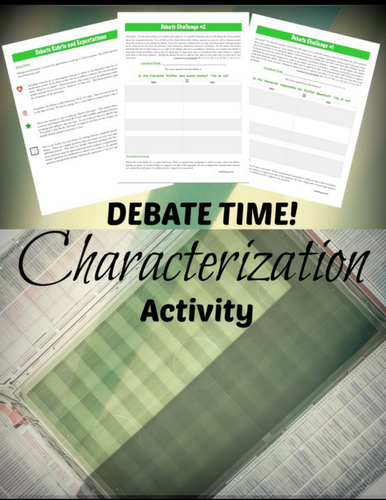
This listing is for a characterization activity entitled "Debate Time!" in which students debate on various topics relating to characterization using textual evidence.
This mini-lesson is part of the Mega Characterization Bundle of over 15 characterization mini-lessons that get your students working with all literary devices and techniques. You can find it listed separately in our store.
Bundle and save over $15.00!
For this mini-lesson:
"Debate Time!"
Task
To debate different aspects of characters using textual evidence to support character analysis
Objectives
To develop criteria for analyzing character
To support analysis with textual evidence
To use rhetorical skills for constructing and supporting an oral argument
To construct an effective argument supported with logical reasoning and textual evidence
Common Core Standards
R1, 3, 6, 11/ W1, 2, 4, 10/ SL 1, 3, 4, 6/ L1-3
Instructions
One of the most engaging and interactive ways to get students involved in class discussion is through a debate. For the FIVE debate activities included in this listing, you will assign your students to a specific character from a specific piece of literature. Then, students will answer the yes or no “focus question” for the debate activity by providing textual evidence, reasons, and character traits to support each side of the debate for the assigned character. Each debate activity also includes an optional “Post-Debate Write-up” that students can complete after they have debated the question in class. This writing activity will help students to synthesize the class debate and arrive at their own character analysis.
If you would like to assess the quality of student responses as well as create a more independent debate, consider using the rubric included here in this packet. This rubric requires students to speak a certain number of times, and students are assessed on the quality and depth of what they say—not just for merely speaking. There are also ways for students to earn bonus points during the discussion according to this rubric. The checks and symbols on the rubric are how I notate student credit during the debate.
Overall, these discussions will get your students involved in analyzing literature on a deeper level and using textual evidence to support arguments.
This mini-lesson is part of the Mega Characterization Bundle of over 15 characterization mini-lessons that get your students working with all literary devices and techniques. You can find it listed separately in our store.
Bundle and save over $15.00!
For this mini-lesson:
"Debate Time!"
Task
To debate different aspects of characters using textual evidence to support character analysis
Objectives
To develop criteria for analyzing character
To support analysis with textual evidence
To use rhetorical skills for constructing and supporting an oral argument
To construct an effective argument supported with logical reasoning and textual evidence
Common Core Standards
R1, 3, 6, 11/ W1, 2, 4, 10/ SL 1, 3, 4, 6/ L1-3
Instructions
One of the most engaging and interactive ways to get students involved in class discussion is through a debate. For the FIVE debate activities included in this listing, you will assign your students to a specific character from a specific piece of literature. Then, students will answer the yes or no “focus question” for the debate activity by providing textual evidence, reasons, and character traits to support each side of the debate for the assigned character. Each debate activity also includes an optional “Post-Debate Write-up” that students can complete after they have debated the question in class. This writing activity will help students to synthesize the class debate and arrive at their own character analysis.
If you would like to assess the quality of student responses as well as create a more independent debate, consider using the rubric included here in this packet. This rubric requires students to speak a certain number of times, and students are assessed on the quality and depth of what they say—not just for merely speaking. There are also ways for students to earn bonus points during the discussion according to this rubric. The checks and symbols on the rubric are how I notate student credit during the debate.
Overall, these discussions will get your students involved in analyzing literature on a deeper level and using textual evidence to support arguments.
Something went wrong, please try again later.
This resource hasn't been reviewed yet
To ensure quality for our reviews, only customers who have purchased this resource can review it
Report this resourceto let us know if it violates our terms and conditions.
Our customer service team will review your report and will be in touch.
$3.00
